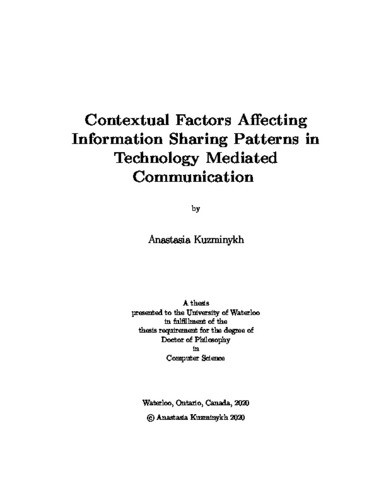| dc.description.abstract | In this thesis, we investigate how and what contextual factors affect user’s information sharing. We build our work on six individual research projects which cover a variety of systems (search engines, social network sites, teleconferencing systems, monitoring technology, and general purpose conversational agents) in a variety of communication scenarios with diverse relationships and dispositions of users. Alongside detailed findings for particular systems and communication scenarios from each individual project, we provide a consolidated analysis of these results across systems and scenarios, which allows us to identify patterns specific for different system types and aspects shared between systems.
In particular, we show that depending on the system’s position between a user and an intended information receiving agent – whether communication happens through, around, or directly with the system – the system should have different patterns of operational adaptation to communication context. Specifically, when communication happens through the system, the system needs to gather communication context unavailable to the user and integrate it into information communication; when communication happens around the system, the system should adapt its operations to provide information in the most contextually suitable format; finally, when a user communicates with the system, the role of the system is to “match” this context in communication with the user.
We then argue that despite the differences between system types in patterns of required context-based adaptation, there are contextual factors affecting user’s information sharing intent that should be acknowledged across systems. Grounded in our cumulative findings and analysis of related literature, we identify four such high-level contextual factors. We then present these four factors synthesized into an early design framework, which we call SART according to the included factors of space, addressee, reason, and time. Each factor in SART is presented as a continuum defined through a descriptive dichotomy: perceived breadth of communication space (public to private); perceived specificity of an information addressee (defined to undefined); intended reason for information sharing (instrumental to objective); and perceived time of information relevance and life-span (immediate to indefinite). | en |

